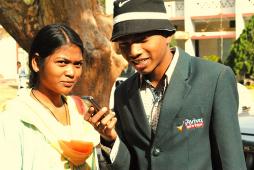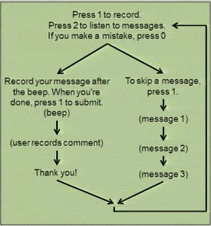The foremost challenge is political. CGNet Swara operates in a region with political unrest. The audio news service lets anyone record and listen to news content which authorities could consider developing a 'loose cannon,' Choudhary worried.
In India, the only FM radio station allowed to broadcast news and current affairs is All India Radio, and community radio licenses are difficult to obtain, especially in Chhattisgarh. In many ways, the CGNet Swara system sidesteps these political hurdles by creating an audio service that so far has escaped regulation.
That is not to say that regulations will not change. A more political attempt to broadcast audio news over mobiles in Zimbabwe resulted in the mobile service provider shutting down several of the SIM cards for the service, fearing retribution from government. A similar fate could await here. In fact, Swara's servers have been shut down twice by their hosts without any explanation. IPSnews puts the issue well: "longevity remains challenged by the political nature of the area CGNet Swara serves, where police and administrative officials have the powers to shut down any operation perceived as "helping" the Naxal movement."
There are some technical challenges entangled with the political challenges as well. Technology that bridges PSTN (Public Switch Telephone Network) with VoIP (Voice Over Internet Protocol) is illegal in India, and VoIP numbers are tough to obtain. As a result, CGNet Swara had to sometimes operate over analog telephone lines. Analog telephone lines support fewer concurrent calls, have lower voice quality, and are less reliable.
In addition, the software that Swara is using doesn't allow for identification of the phone numbers that are calling in. This means that the moderators cannot see who is calling in to record and listen to news (from where), and modify their system accordingly. While Choudhary feels this lack of identification enhances security, mobile operators already have much of the information available to them.
This relates to another challenge: the security of reporters and listeners. Because Swara users are making phone calls from their mobile phones, mobile network operators have a record of exactly who is calling into the system. This could theoretically enable authorities to harass individuals who make use of the system if they end up taking an unfavorable stance against the system.
Another potential challenge is effective moderation of the recordings. As usage grows and more reports are called in, moderation will become more expensive and time-consuming. Choudhary notes that now when the reports come in, every report is either verified through examination (or labeled as unverified, on a case by case basis). Each audio clip is also edited for sound and clarity. As the service scale, more moderation will be required.
Finally, the project faces a challenge in soliciting content from the marginalized languages Kudukh, Gondi, and Chhatisgarhi. Half of the content that has been reported to the system is in Hindi, the least marginalized of the languages. Choudhary said the team was keen to receive messages especially in Kudukh and Gondi, but reaching areas when only those languages are spoken will require innovative ways of advertising, like partnering with cultural song and dance troupes. The Swara team has not done so yet.

 CGNet Swara is a new audio-based citizen journalism service in Chhattisgarh, India. Citizen journalists can call a phone number to record news, and listeners can call in to hear news recorded by citizens around them. When citizen journalists call, they simply press 1 to record news and record some audio onto the system. Listeners can call the same number, press 2, and hear the last three items that the moderators have selected to be published on to the service.
CGNet Swara is a new audio-based citizen journalism service in Chhattisgarh, India. Citizen journalists can call a phone number to record news, and listeners can call in to hear news recorded by citizens around them. When citizen journalists call, they simply press 1 to record news and record some audio onto the system. Listeners can call the same number, press 2, and hear the last three items that the moderators have selected to be published on to the service.